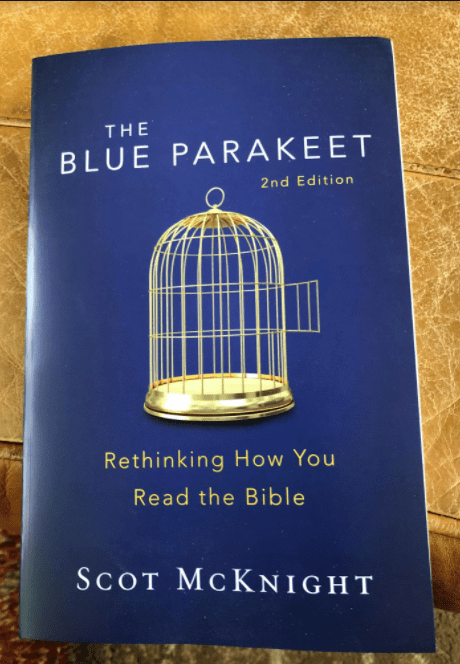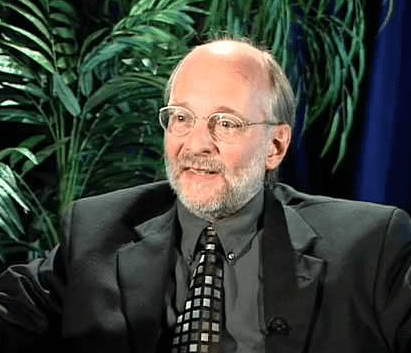Matthew Lunders and Becky Castle Miller serve on the pastoral staff of Damascus Road International Church in the Netherlands. They both worked as journalists before going into vocational ministry. They wrote this dialogue between two disciples dealing with the ascension aftermath as a script and performed it for the church to help them engage their imaginations in studying the Bible.
All three pics are by Ger van den Elzen <https://www.instagram.com/ger_van_den_elzen_photography/>
Damascus Road website
Damascus Road YouTube channel
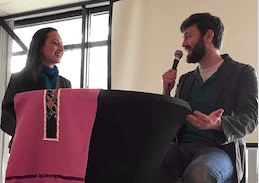 Mary of Magdala stood in the corner, facing the open window. From up here, she could see the rooftops of smaller houses and the roads winding between them. Everything was the same shade of drab, the monochrome only broken by a few travelers in weird and wild colors, the earliest arrivals for the upcoming festival. She held her arms high and mouthed her prayers. “Hear, O Israel, the Lord our God, the Lord is one. Love the Lord your God with all your heart, with all your soul, and with all your strength. These commandments that I give you today are to be on your hearts—”
Mary of Magdala stood in the corner, facing the open window. From up here, she could see the rooftops of smaller houses and the roads winding between them. Everything was the same shade of drab, the monochrome only broken by a few travelers in weird and wild colors, the earliest arrivals for the upcoming festival. She held her arms high and mouthed her prayers. “Hear, O Israel, the Lord our God, the Lord is one. Love the Lord your God with all your heart, with all your soul, and with all your strength. These commandments that I give you today are to be on your hearts—”
“Mary!”
The greeting shout interrupted her. She turned to see John ripping off his traveling cloak as he skidded into the room with a cloud of dust.
“Welcome…home?” She laughed at the awkwardness of playing hostess in a house that wasn’t hers. They had all been coming and going from this large home in Jerusalem since Peter and John had first borrowed the upstairs room for the night…well. That night. The last night. The kind man who owned the house had made it available to them as a sort of home base throughout the chaos—the grief and the joy—of the last month.
With one hand, Mary pulled her scarf back up over her black curls and with the other, she reached to take John’s cloak.
“How’s Mama Mary?” he asked, kicking off his sandals.
“Fine. She’s praying up on the roof, but she’ll be glad to see her favorite adopted son when she comes in.” She stood on tiptoes to look over his shoulder at the doorway. It was still empty. “Where’s our rabbi and the others?”
“Do you have to ask? I’ve already proven I can run faster.” He smirked.
She rolled her eyes.
“The others are coming, but Jesus is…” John crinkled his forehead and opened and closed his mouth, as if trying to find the right word. “Gone.”
The bright morning light dimmed around the edges of her vision, closing in on his face. She blinked but it didn’t clear, and she stumbled forward, dropping his cloak. Though he was right in front of her, his voice calling her name sounded muffled and far away. Her knees wobbled, and she dropped onto a wooden bench. “Gone?”
John slid onto a leather stool near her and lightly smacked her hand a few times. “Mary, are you okay? It’s okay!” He grabbed the clay pitcher from the low table nearby and poured water into a cup for her while his words poured out in an effort to explain. “It’s okay. He was there, we saw Him, and then He went up…on a cloud. I know it sounds crazy, but what hasn’t been crazy recently, right? But He told us to come back here and wait.”
Mary shook her head, confused. “He led you to Bethany just so He could…leave…and send you back to Jerusalem?”
“Well, I hadn’t thought about it that way. I mean, I suppose he took us to Bethany so Martha and her siblings could see Him too. I don’t know.” Now John was shaking his head too.
Mary gulped her drink. “Okay. Start from the beginning. What happened?”
“The beginning…where to begin the story? It’s all happened so fast. Jesus is dead. Jesus is alive. Jesus is here. Jesus is there. Jesus is up…there.” He waved at the ceiling. “He said we should wait…” He looked left and squinted. “He said we should wait for the promise from His Father. He said the Holy Spirit would come to give us power to be witnesses about what we’ve seen.”
“I still don’t understand. We just got Him back, and He’s gone again? What are we going to do now?”
He sucked in air and exhaled in a loud gust. “I don’t know. I don’t understand it either. But—but I do have hope.”
“How can you feel hope? I’ve barely recovered from losing Him the first time. If He’s really gone, I won’t survive mourning Him again.” Her eyes burned, and her throat felt tight.
“But he’s not gone gone. After he disappeared, these two guys in white showed up. They told us that He’s gonna to be coming back.”
She gritted her teeth. “Maybe you could have led with that information?”
John ducked his head. “Sorry. But that wasn’t at the beginning. I’m still processing it all myself. They didn’t say how long He’ll be gone, just that He will come back someday, in the same way we saw Him go.”
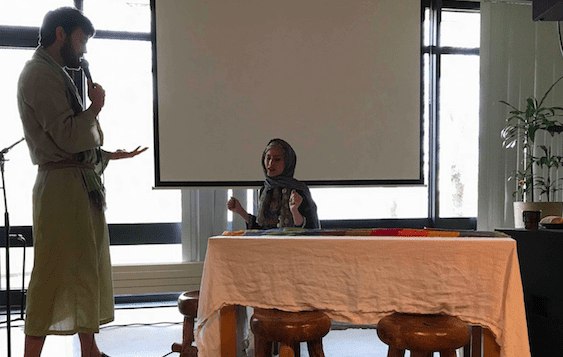 Mary remembered her friend on the roof, the woman who had stood like iron, watching her son tortured and killed. Who had received Him back from the dead with delight and was now suddenly bereaved again. “What are you going to tell his mom?”
Mary remembered her friend on the roof, the woman who had stood like iron, watching her son tortured and killed. Who had received Him back from the dead with delight and was now suddenly bereaved again. “What are you going to tell his mom?”
He tipped his head to the side. “Don’t you think she knows? Even though we’ve been all over the place lately, He did make sure to spend time with her. I saw them the other day, sitting in the shade.” One side of his mouth turned up, and he softened his voice. “She was on a chair, and he was on the ground next to her with His head on her knee. I don’t think He left without saying goodbye to her.”
Mary stood and carried the pitcher to a bucket where she refilled it. She spoke with her back to him. “He didn’t say goodbye to me.” John either didn’t hear her or didn’t have a response.
She returned, poured a drink for him, and refilled her own cup. She asked again, “What do we do now?”
“I don’t know. But…even though I’m confused, I can’t shake this excitement. When Jesus went up, we were full of joy—me and all the others.”
The tense tangle in Mary’s gut started to loosen. Maybe Jesus wasn’t gone for good. Maybe He hadn’t abandoned them, or been taken away from them again. She’d get a more coherent story out of one of the older disciples when they arrived. James would know. She glanced out the window, but there was no sign of them yet.
She sat next to John and leaned toward him. “Before the others get here, I’ve been wanting to ask you…how is Peter? I’m worried about him. The angel at the tomb specifically said to ‘tell the disciples including Peter.’ I know there must have been a reason, but I didn’t want to ask Peter directly.”
John laced his fingers together and rubbed one thumb with the other. “I think I know. Don’t tell him I shared this, but the night Jesus was arrested, we both went to the High Priest’s. I could get in easier to see the questioning, but Peter at first wasn’t allowed in, so I talked to the woman at the gate and worked it out. But then…I don’t know what came over him. Someone asked him if he was a disciple of Jesus, and Peter said he didn’t even know Jesus!”
“What? Are you sure you heard correctly?”
John nodded, then shook his head, then nodded again. “I thought I heard wrong at first, but then it happened two more times! An hour earlier, he was swearing he would die with Jesus, and then he denied him three times. I don’t know what changed. He was yelling and calling down curses on himself—stuff even I wouldn’t say. Then he just ran out. Everything was loud, there was the trial and soldiers and roosters, but even outside I could him weeping. I’ll never forget that sound.”
Mary clasped her hands on her chest. “Oh, Peter. How horrible. Why didn’t you go to him?”
“Dunno. It just seemed better to stick with Jesus.”
“Of course.” She sighed. “He must have felt devastated afterward. I can’t imagine. They were so close. No wonder the angel made a point to tell Peter Jesus was alive. Do you know if Peter talked to Jesus about it later?”
“Well, Jesus knew. He looked right at Peter the last time as he was shouting and making a scene. I don’t know if they really talked about it after Jesus came back, but sort of.”
Mary raised an eyebrow. “What do you mean?”
“So…back when we went to Galilee because you told us to. We didn’t know what to do, so Peter recommended we go fishing while we waited. We didn’t catch anything all night. You’d think we had never been on a boat before. My dad would have been so mad.” John cringed.
Mary got up and went around the corner. “Keep talking, I’m listening.”
“In the morning, there was a man on the shore who told us to try the right side. Seemed impolite not to, so we did, and there were tons of fish, and then I knew, it was Him.”
Mary came back with a basket of bread and placed it on the table as she sat. “Because the same thing had happened to you before, right?”
“Yeah, when Jesus first called us! Funny, right? So it happened again, we went to shore, Jesus made this great breakfast. Oh…” He halted the flow of words. “I’m going to miss food with Him.”
Tears prickled the inside corners of Mary’s eyes. “Oh, yes. The way He delighted in the simplest meals!” She could picture Him as He had been at so many tables they had all shared together, hardly taller than her at His full height, grinning just the way His mom did, standing and giving thanks to God for the food. “He made bread into a feast.”
Even John sat contentedly silent for a moment.
Mary took the bread from her basket and tore it. She offered half to John and cleared her throat. “What happened next with Peter?”
“Um, Jesus took Peter on a walk down the shore, and Jesus asked Peter if he loved Him.”
“Wait. Were you eavesdropping on them? John!”
“Maybe.” He shrugged and grinned. “You know how sound travels across water?” He shoved a chunk of bread in his mouth.
Mary crossed her arms. “Uh-huh.”
“Aaaaaaaanyway. Jesus asked Peter three times if he loved Him.”
“Like the three times Peter denied him? Huh. How did Peter respond?”
“He said yes, of course,” he mumbled around the bread. “But it was more about what Jesus said after that. He said, ‘Take care of my sheep.’ It was like He gave Peter his job back. Gave him a second chance. And Peter seems so far like he’s taking that seriously. He’s been encouraging us, getting us to pray. Talking about the future. He thinks we should find someone to replace Judas, to be part of the team going out after we get this power Jesus talked about.”
“How could you possibly find someone to fill in for Judas? I know there are other followers who have been with us from the beginning, but Judas is—was—” she corrected herself. “Was one of the Twelve. There’s so much he got to see and learn that others missed.”
“I remember Judas talking about the first time he and Simon drove out a demon when Jesus sent us out and you’d think since Simon was a Zealot that he’s this manly guy, right, but he almost peed himself, he turned white and Andrew started laughing at him…” John’s mouth could run like his feet when he got into a story. His words tumbled on, oblivious to Mary’s pained expression.
Those dark days. She never thought about them when Jesus was around. The very light of His presence drove those memories far away. What would happen now that He was gone? No one else had had the ability to save her. Would the darkness come back?
John was still talking. She tried to interrupt him. “John. John!”
He didn’t hear her. “It was hilarious. Judas could tell the story so much better than I can. Man, that was a rush!”
She got louder. “Hey! Thunder-head! Demons are not a laughing matter. Speaking from experience here.”
“I know, right?” He took another big bite of bread. “The guys talked about that, too. You had it bad. We’re like, Jesus has gotta do this one, it’s too big for us. But then it was all, ‘Arrrghhhh!” His enthusiastic performance spluttered crumbs into the air.
Mary leapt up. “It’s not funny!”
He stopped talking and looked at her, wide-eyed. He swallowed.
She closed her eyes and took a slow breath. She reached out and patted his head, sending up dust that sparkled in the sunbeam. “You are still so young…and immature sometimes.”
***
John tossed his bread on the table. “You’re right. I’m sorry.”
He sipped his water while Mary rearranged her veil, smoothed her skirt, and sat. He gave her time to fit in one more huff of annoyance before he spoke again.
“About Judas. You want to know how we choose someone else? To be honest, we weren’t sure why Jesus picked the Twelve of us to begin with. What did He see in us? What did He see in Judas?”
“After all that Jesus taught Judas, how could he betray Him?” she asked.
“The weirdest part is that Jesus predicted it.” He reached for the table and ran his hand over the wood, remembering that night in this same spot. He had reclined there, right by Jesus. “Earlier in the night, before Jesus was arrested.” He stood and walked to the spot where Jesus had stood. “We were about to have dinner, and Jesus got up, wrapped a towel around Himself like He was a servant, and washed all of our feet. Even Judas’s. At the time I didn’t think much of it, but how hard can a heart be?”
She glanced over as though she could see the traitor there still. “And after that Judas just got up and went to get the soldiers?”
“He ate a bit with us first. That’s when Jesus told us someone would betray Him. We were all trying to find out who. My bet was Bartholomew. Peter thought I could get the secret out of Jesus. But Jesus just handed bread to Judas…then he left.”
She leaned closer and dropped her voice. “Do you think he did it for the money? I heard he got thirty pieces of silver for handing Jesus over.”
“It could be. I mean, it turns out he was stealing from the money bag.”
Mary looked down at her hands in her lap.
“You don’t seem surprised.”
“I…had my suspicions near the end. I overheard what he said in Bethany a couple months ago when Martha’s sister Mary anointed Jesus with that expensive perfume. He was more obsessed with the price than with her beautiful act of worship!”
John breathed in. He could almost smell the ointment again. What honor their fellow disciple had shown to Jesus. What a contrast with Judas’s shame.
Mary asked, “How did you find out for sure that Judas had been stealing?”
“We finally let Matthew look over the accounting. Some of the guys don’t trust him because he was a tax collector, but he’s good with numbers. Judas had been the only one with the purse, and there was a lot missing.”
“A traitor and a thief.” Her nostrils flared. “And yet he was one of us.”
“And he did it all to Jesus’s face! After dinner, we went out to the garden, and when Judas showed up with the soldiers, he walked right up to Jesus and kissed him. Called him ‘Rabbi.’”
“How dare he?” Mary jumped up. She hissed through a clenched jaw, “It’s a good thing I wasn’t there that night. I would have—”
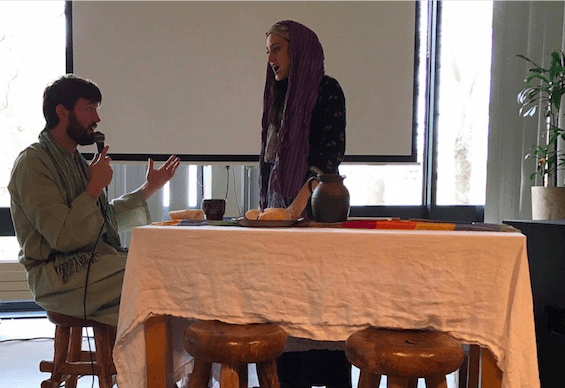
John cut in. “I know! I wanted to call down fire on him. Kinda surprised Peter didn’t try to take a stab at him while he was swinging that sword around. If Judas wasn’t dead, I’d be tempted to kill him myself.”
Mary’s shoulders sagged. “Don’t say that.”
John pursed his lip to hide his smile. He had known her compassion would catch up with her anger at some point, but he hadn’t thought it would be that quick. He was pretty sure she was reproaching herself inwardly as she corrected him outwardly.
She picked up John’s cloak from the floor and folded it over her arms, hugging it to herself. “Don’t. It’s horrible enough. The way he died…his intestines bursting out everywhere.”
“What?” John’s eyebrows shot up. “Matthew just told me Judas hanged himself.”
“Everyone in Jerusalem is saying he fell headlong in a field and just burst.”
John had flayed and gutted plenty of fish, and he couldn’t help imagining the innards of fish extrapolated up to human size. He shivered and wanted to drop the whole subject. He felt twitchy in the silence but held himself still while Mary stood quiet. He watched her facial expression change several times.
“I’m not glad he’s dead,” she said finally. “I wish I could talk to him. He gave the blood money back to the priests out of guilt. He knew what he did was wrong. I think if Judas were alive, Jesus would give him a second chance, too. Jesus would be faithful and just and would purify him from his sin.”
“I’m sure you’re right. But I don’t know how I feel. I’m angry that Judas betrayed all of us, but I am sad that he’s gone.”
Mary mused for a moment. “I wonder what made the difference between Peter and Judas.” She held out one hand with her palm up. “Peter betrayed Jesus. Called down curses on himself. But then, he held on to life long enough to be forgiven and have purpose, a mission.” Now she raised her other hand, as though mimicking a set of scales. “Judas betrayed Jesus. Admitted his sin. But then threw his life away. It’s like, after all that teaching, he still didn’t understand who Jesus was, what He was like. I don’t think Judas had any hope that Jesus could forgive him.”
John joined in the flow of thought. “You know, there’s another similarity. I had forgotten until now. At dinner that night, after He washed our feet, Jesus also predicted Peter’s failure. He warned Peter he would deny Him.”
“Whoa. That must have made Peter feel even worse when it actually happened. What do you think eventually gave him hope?”
He looked through his mind for an answer. “Maybe it’s not what you do, but who you love. Peter—for all his faults—he was honest that he really does love Jesus. Judas? Maybe he tried to love God and the world at the same time. Maybe he tried to have two masters.”
She snorted. “The world is not a good master. What did it ever do for him? Certainly nothing worth loving. But I feel like I can love God because God first loved me.” She paced to the open part of the room as she talked. “I know who Jesus is. And I know that He loves me. And I’m starting to feel that excitement you talked about. I have no idea what’s next for any of us, but I’m not afraid. If Jesus taught me anything, it’s that there is no fear in love.”
“Wow. That’s beautiful.” John was glad to see the change in Mary’s demeanor.
“You know He loved you, too, right? All of us could see it.” She looked sideways at him. “Some of the other women were calling you ‘the Beloved One.’”
He ignored her sarcastic tone because he liked the sound of that nickname. “That’s a good name. I hope I live up to it. I want to love others the way He loved me.”
She reassured him. “You will! You’ll get to tell so many about His love. But don’t just tell them. Don’t just love with words or speech, but with actions and in truth.”
“That’s a good line. I might use that someday.” His response came out half-joking because he had half-intended it to be that way.
“Always kidding. I was trying to be serious.” She threw his cloak at him.
He shielded himself. “What, I was being serious!”
“Okay, ‘Beloved One.’ Since the others are on their way and you are the fastest disciple alive, why don’t you run out and get us some food?”
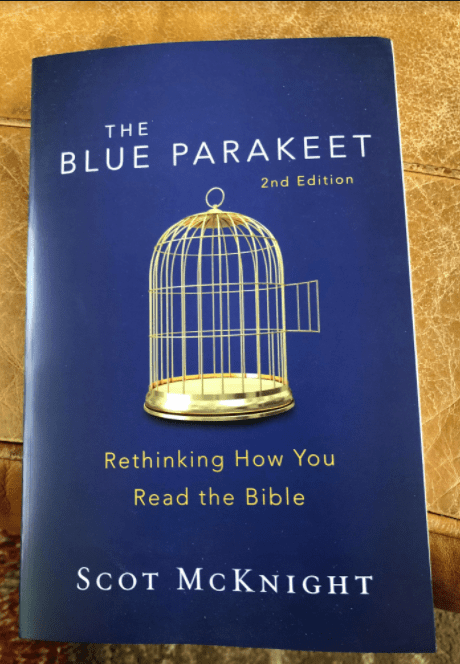 I’ve been asked a dozen times or more, What’s new in the Blue Parakeet?
I’ve been asked a dozen times or more, What’s new in the Blue Parakeet?

